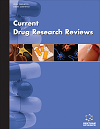- Home
- A-Z Publications
- Current Drug Research Reviews
- Previous Issues
- Volume 13, Issue 1, 2021
Current Drug Research Reviews - Volume 13, Issue 1, 2021
Volume 13, Issue 1, 2021
-
-
Identification of Drug Candidates for Breast Cancer Therapy Through Scaffold Repurposing: A Brief Review
More LessAuthors: Jubie Selvaraj, Thangavelu Prabha and Neetu YadavConventional drug discovery is a time consuming and expensive expedition with less clinical preference achievement proportion intended for breast cancer therapy. Even if numerous novel approaches to the conformation of drugs have been introduced for breast cancer therapy, they are yet to be implemented in clinical practice. This tempting strategy facilitates a remarkable chance to take the entire benefit of existing drugs. D Read More
-
-
-
SeDeM Expert System, an Innovative Tool for Developing Directly Compressible Tablets: A Review
More LessAuthors: Inderbir Singh, Ajay K. Thakur, Rajni Bala and Reecha MadanBackground: SeDeM (Sediment Delivery Model) expert system is a preformulation tool employed for evaluating direct compression suitability of various excipients. SeDeM is a 12 parameters derived diagram and SeDeM-ODT (Sediment Delivery Model-Orodispersible tablets) is a 15 parameters derived diagram that can be used as a research tool for reducing the product development time. The best possible excipien Read More
-
-
-
Onychomycosis: Current Understanding and Strategies for Enhancing Drug Delivery into Human Nail Tissue
More LessBackground: Onychomycosis is by far the most common finger or toe nail fungal infectious disease caused by dermatophytes, non-dermatophytic molds or yeast. It accounts for 50% of the total nail disorders, and affects patients physically, socially, and psychologically and can seriously influence their quality of life. Objectives: Oral antifungals are routinely used to treat the nail fungal disease; however oral therapy is asso Read More
-
-
-
Design and Evaluation of Eudragit RS-100 Based Itraconazole Nanosuspension for Ophthalmic Application
More LessAuthors: Pravin Pawar, Anita Duduskar and Swati WaydandeBackground: Poor water soluble compounds are difficult to develop as drug products using conventional formulation techniques. Objective: In the present study, the potential of Eudragit RS-100 nanosuspension as a new vehicle for the improvement of the delivery of drugs to the intraocular level was investigated. Methods: Solvent evaporation technique has been employed for nanosuspension preparation. Surfactant concent Read More
-
-
-
Validation of Texas Christian University Psychosocial Functioning and Motivation Scales in Iranian Persons Who Use Drugs
More LessAuthors: Sana Shahrabadi, Amir Jalali, Rostam Jalali and Nader SalariBackground: The psychosocial functioning and motivation scales of the Texas Cristian University (TCU) were translated and validated for the Persons Who Use Drugs (PWUDs). Methods: This study was carried out as a methodological research. The scales were translated forward and backward and then, the PWUDs in Kermanshah-based (west of Iran) substance abuse treatment centers in 2019 filled out the scales. Participants inclu Read More
-
-
-
Therapeutic Potential of Antileukotriene Drug-Camellia sinensis Extract Co-Formulation on Histamine Induced Asthma in Guinea Pigs
More LessAuthors: Neelam Singh, Giriraj T. Kulkarni and Yatendra KumarBackground/Objective: To study the therapeutic potential of Antileukotriene drug- Camellia sinensis extract co-formulation on histamine induced asthma in guinea pigs. Methods: SRSD of Montelukast sodium was prepared by the solvent evaporation method. Lyophilized aqueous extract of Camellia sinensis leaves and SRSD mixture was filled in capsule and the capsule shell was coated to achieve initial release lag time. In vit Read More
-
-
-
Repurposing of Benzimidazole Scaffolds for HER2 Positive Breast Cancer Therapy: An In-Silico Approach
More LessBackground: A newer trend has been seen recently to reuse the conventional drugs with distinct indications for the newer applications to speed up the drug discovery and development based on earlier records and safety data. Most of the non-cancerous agents could afford a little or tolerable side effects in individuals. However, the repositioning of these non-cancerous agents for successful anticancer therapy is an outstanding Read More
-
Most Read This Month
Article
content/journals/cdrr
Journal
10
5
false
en


